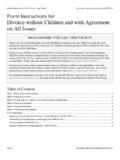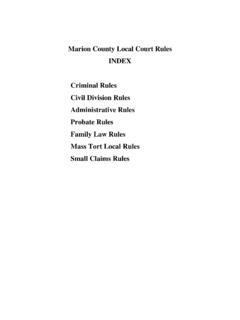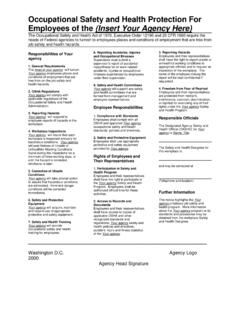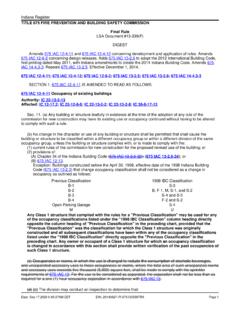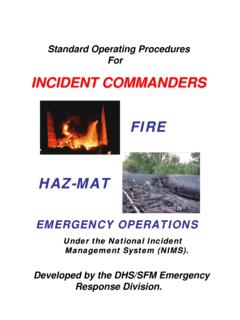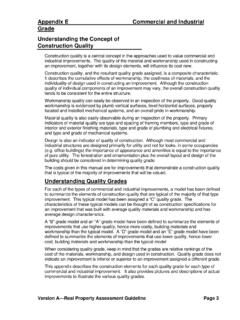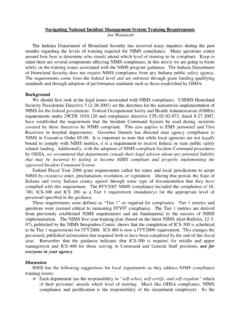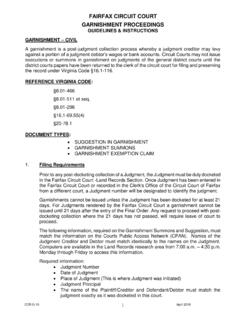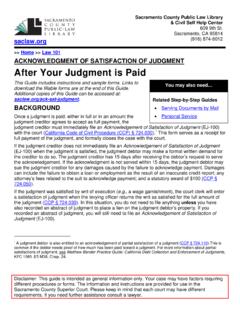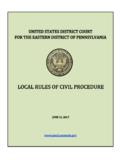Transcription of FAILURE TO RULE ON A MOTION AND DELAY OF …
1 PROCEDURAL ISSUES CONTACT: FAILURE TO RULE ON A MOTION Aaron Johnson AND DELAY OF JUDGMENTS. Trial Rules and Introduction These Trial Rules are officially titled FAILURE to rule on MOTION and Time for holding issue under advisement; DELAY of entering a judgment but are commonly known as the lazy judge . rules. Trial court clerks perform an important duty under these rules, and there are significant differences in procedures between the two rules. Trial Rule To invoke the rule, an interested party must file a praecipe with the clerk of the court where the case is pending and specifically designate the MOTION or decision the court has delayed. Ind. Trial Rule (E). The trial court clerk's first duty is to enter the date and time of the filing on the praecipe , and record the filing in the chronological case summary (CCS). The clerk then must forward the praecipe and a copy of the CCS to the Chief Administrative Officer of the indiana Office of Judicial Administration.
2 The clerk does not have a role in determining whether the submission should be withdrawn; that task is now performed by the Chief Administrative Officer. The general rule provides: The court must either set a MOTION for hearing or, if a hearing is not required, enter a ruling on the MOTION within thirty (30) days after the filing. (A). If the court has acted within the thirty-day period to schedule a MOTION for hearing, the actual hearing itself may take place outside the thirty-day window. 1. Once a court holds a hearing on a MOTION , the court has thirty (30) days to rule of the MOTION . Id. Allowing parties time to file post-hearing briefs or findings does not extend the court's time to rule, without an agreement on the record by all parties. The exceptions to the general rule provide that the time limitation does not apply: 1. See, , State v. Hurst, 688 402 (Ind.)
3 1997). Last updated 7/1/2021 1. during any period after the case is referred to alternative dispute resolution and until a report on the alternative dispute resolution is submitted to the court, when the court within thirty (30) days after filing, orders that the MOTION be considered during the trial on the merits, when the parties who have appeared or their counsel stipulate or agree on the record that the time limitation for ruling on a MOTION shall not apply or be extended for a designated period of time, the time limitation for ruling has been extended by the Supreme Court, 2. the ruling in question involves a repetitive MOTION , a MOTION to reconsider, a MOTION to correct error, a petition for post- conviction relief 3, or a ministerial post-judgment act. Under Ind. Trial Rule (C) a court is deemed to have ruled or decided at the time the ruling or decision is entered into a public record of the court or at the time the ruling or decision is received in the office of the clerk of the court for filing.
4 A statement from the judge that he has decided how he is going to rule is not sufficient. 4. The Chief Administrative Officer will issue a Notice either granting or denying withdrawal of the submission. This Notice will be sent to the trial court clerk who records it on the CCS and provides written notice to the judge and the parties. If the Chief Administrative Officer determines the ruling or decision has been delayed, the withdrawal is effective as of the time of the filing of the praecipe . The matter is then in the 2 Under (D), a court may apply to the Supreme Court for an extension of the time limitation. The application must be filed prior to the filing of a praecipe and the application must also be served on the trial court clerk. Withdrawal of submission may not take effect during the pendency of the application before the Supreme Court. If the time limitation expires while the application for extension is before the Supreme Court, the trial judge's jurisdiction over the case is suspended.
5 3 does not apply to petitions for post-conviction relief. White v. State, 793 1127 (Ind. 2003). Trial Rule does not apply to post-conviction relief proceedings. Williams v. State, 716 897 (Ind. 1999) fn. 3. Also note, a MOTION to correct erroneous sentence filed pursuant to 35-38-1- 15 must be considered a petition for post-conviction relief exempted from the application of State ex rel. Gordon v. Vanderburgh Circuit Court, 616. 8 (Ind. 1993). 4 it should be unnecessary for a party to be required to check the judge's bench docket. The timeliness of the filing of the praecipe should be a matter determinable from the records maintained in the Clerk's office. Rolf v. Rolf, 287. 865, 259 Ind. 386 (1972). Last updated 7/1/2021 2. hands of the Supreme Court to appoint a Special Judge to take jurisdiction of the case. Trial Rule The procedure followed under is very much the same as the procedure followed under However, there are significant differences between the two rules.
6 Applies when a case has been tried to the court and taken under advisement by the judge. Under , if a judge takes a cause tried to the court under advisement and fails to determine any issue of law or fact within ninety (90) days of the submission of all pending matters, the case may be withdrawn from the judge. Ind. (A). A court is considered to have a matter under advisement once the submission of evidence has concluded. [T]he offering of additional briefs, arguments, proposed findings, or other documents that may be helpful to the court, but which are not evidence do not by themselves effect the time within which a ruling may be required under Ind. Trial Rule State ex rel. Koppe v. C a s s Circuit Court, 723 866 (Ind. 2000). As with , the first step in invoking is the filing of a praecipe by an interested party. The praecipe must be filed with the trial court and not directly to the indiana Supreme Court.
7 The remainder of the process under mirrors , though the exceptions under are more limited. The ninety (90) daytime limitation of does not apply where: the parties who have appeared or their counsel stipulate or agree on record that the time limitation for decision shall not apply, or the time limitation for decision has been extended by the Supreme Court. The most significant difference between these two rules is that does apply to petitions for post-conviction relief. The county attorney can serve as another resource to clerks for assistance with the application of this rule. Last updated 7/1/2021 3.
